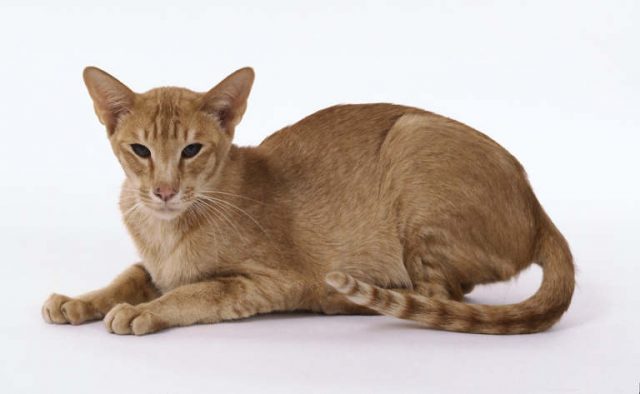Type the name of the breed you're looking for below
[wpdreams_ajaxsearchlite] Don't see the breed your're looking for? Click here and let us know!
Breed Characteristics
1 paw - breed exhibits the least amount of this characteristic
5 paws - breed exhibits most amount of this characteristic
Oriental Shorthair
| Origin And History | In the past, blue-eyed, colourpointed cats were owned by royalty and were kept in the Royal Palace of Siam. The Siamese breed, however, is only one of several varieties native to the area. The Cat-Book Poems, a manuscript written in Siam (now Thailand) some time between 1350 and 1767 A.D., describes and shows a variety of cats native to the area, including solid black, black and white bicolour, solid brown, blue/gray, and shaded silver, as well as cats bearing the point-restricted colour pattern. The cats portrayed in the book had slim bodies and legs, large ears, and tapered muzzles, much like that of today's Siamese and the related breeds. The first cats imported to England from Thailand were often solid or bicoloured. It wasn't until the 1920s when the Siamese Cat Club issued a statement excluding all other colours that the blue-eyed pointed cat became the Siamese norm in Britain. The concept of cats with the Siamese body style but with a wide range of colours and patterns had captured the interest and imagination of cat fanciers. It was only a matter of time before these cats entered the cat fancy, with a little help from breeders with a flair for exterior decorating. The Oriental seen in the show halls today is not a direct import from Thailand, but rather a Siamese hybrid developed in the 1950s and 1960s. The breed's creation was deliberate, breeders wanted a cat that looked and acted like a Siamese but that came in a wider range of colours. In the 1950s British breeders crossed Siamese cats with domestic shorthairs and Russian Blues. In the late 1960s American breeders, fascinated with the British Orientals, took up the torch and crossed Siamese, domestic shorthairs, and Abyssinians to create a new look. Body style was not sacrificed for color and pattern, and backcrosses to the Siamese preserved type and personality traits. The Oriental breeders met with initial resentment from Siamese breeders who were resistant at best to the idea of another Siamese-type hybrid, but, since the way had already been paved by breeders of the Colourpoint Shorthair (which gained CFA acceptance in 1964), the opposition didn't stop Orientals from gaining ground. In 1972 the CFA accepted the Oriental Shorthair for registration, and granted full Championship status in 1977. Since then, the Shorthair has rapidly increased in popularity. In recent years the Oriental Shorthair has been consistently ranking high among short haired breeds. Since the Siamese has the long haired Balinese, and the Colorpoint has the longhaired Javanese, it seems only right that the Oriental Shorthair should have his own long haired variant, a cat with a long, lean, classy chassis, silky fur, and a full palette of colours to choose from. To that end, the Oriental Longhair is the newest addition to the long line of Siamese-type cats. Although currently rare, the breed is slowly growing in popularity and appeals to the cat lover who wants the elegant body type and personality of the Siamese, the wash-and-wear hairdo of the Balinese, and the myriad of colours of the Oriental Shorthair. |
| Personality | Curiosity and intelligence combine, providing them a means of finding anything and everything. They have been known to open a drawer or empty your purse to discover their favorite toy. It might be a pen or a crumpled up piece of paper that they can chase around the kitchen floor; it really doesn’t matter. Give them the attention and affection they so desperately need, and they will do anything to please you. Ignore them, and they will droop with despair. These elegant, svelte cats remain playful, spirited, and loyal well beyond their youth. |
Physical Attributes
| Appearance | The body type of the Oriental is virtually the same as the Siamese's. What sets the breed apart is the wide variety of colours and patterns. Unlike the Siamese that comes in only four colours and one pattern (although that varies depending upon the cat registry), the Oriental is available in over 300 colour and pattern combinations. Some colours are more common than others; solid ebony is the most common. Pure white, chestnut, blue, and ebony tabby are also popular. However, Oriental breeders are working with just about every possible colour and pattern. |
| Health | The Oriental is in general a healthy breed but can suffer from the same defects as the Siamese, since they are closely related. Protrusion of the cranial sternum is a common, though not serious, defect seen in some Siamese and related breeds. Endocardial fibroelastosis is a more serious anomaly that can be found in some Siamese lines. |



